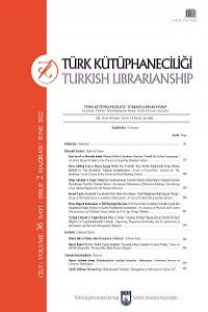Konu Otorite Dizini Nedir? Nasıl oluşturulur?
Konu başlıkları, Otorite işi, Otorite kontolü, Konu otorite dizini, Otorite dizin
What is the Subject Authority File? How is it Created?
Subject headings, authority work, authority control, subject authority file, authority file,
___
- Alkan, N. (1995). Bilgi taramalarında temel başarısızlık nedenleri. Bilgi Dünyası, 9(2), 91-102.
- Atılgan, D. (1987). Kataloglamada standartlaşma. Türk Kütüphaneciliği, 1(2), 71-78.
- Atılgan, D. (1988). Kataloglamanın standartlaşmasında milli kütüphanelerin rolü. Türk Kütüphaneciliği, 2(1), 42-47.
- Avram, H. D. (1984). Authority control and its place. The Journal of Academic Librarianship, 9(6), 331-335.
- Baydur, G. (1985). Konu indekslemesi. Türk Kütüphaneciler Derneği Bülteni, 34(4), 171-184.
- Bayter, M. (2000). Ankara’daki üniversite kütüphanelerinde kataloglama sorunları ve çözüm önerileri. (Yayımlanmamış yüksek lisans tezi). Ankara: Ankara Üniversitesi.
- Bloomberg, M. ve Evans, G. E. (1989). Kütüphane teknisyenleri için teknik hizmetlere giriş. (N. Tuncer, Çev.) Ankara: Türk Kütüphaneciler Derneği.
- Burger, R. H. (1985). Authority work: the creation, use, maintenance, and evaluation of authority records and files. Littleton, Col.: Libraries Unlimited.
- Chan, L. M. ve Salaba, A. (2016). Cataloging and classification : an introduction. Lanham: Rowman & Littlefield Publishers, Inc.
- Cinol, G. (1970). Dizin türleri. Türk Kütüphaneciler Derneği Bülteni, 20(3), 141-146.
- Clack, D. H. (1985). Authority control. Technical Services Quarterly, 3(1-2), 127-140.
- Clack, D. H. (1988). Authority control and linked bibliographic databases. Cataloging and Classification Quarterly, 8(3-4), 35-46.
- Cutter, C. A. (1904). Rules for a dictionary catalog. Washington: U. S. Goverment Printing Office.
- Dickson, J. ve Zadner, P. (1989). Authority control and the authority files: a functional evaluation of LCNAF on RLIN. Cataloging and Classification Quarterly, 9(3), 57-73.
- Dursun, A. (1991). Yetke dizimi (Authority file). (Yayımlanmamış yüksek lisans tezi). İstanbul: İstanbul Üniversitesi.
- Ferguson, B. (2005). MARC / AACR2 / Authority control tagging : a blitz cataloging workbook. London: Libraries Unlimited.
- Harpring, P. (2010). Introduction to Controlled Vocabularies: Terminology for Art, Architecture, and Other Culturel Works. Los Angeles: The Getty Research Institute.
- Haykin, D. J. (1951). Subject headings : a practical guide. Washington, D.C.: U. S. Goverment Printing Office.
- Jeng, L. H. (2010). What authority? Why control? Cataloging and Classification Quarterly, 34(4), 91-97.
- Joudrey, D. N., Taylor, A. G. ve Miller, D. P. (2015). Introduction to cataloging and classification. California: Libraries Unlimited.
- Maxwell, R. L. (2002). Maxwell’s guide to authority work. Chicago: American Library Association.
- Pakin, E. (1990). Dil ve edebiyat alanı için Türkçe konu başlıkları listesi. İstanbul: Türk Kütüphaneciler Derneği İstanbul Şubesi Yayınları.
- Prytherch, R. J. (2005). Harrod’s Librarians’ Glossary and Reference Book : A Directory of Over 10,200 Terrms, Organizations, Projects and Acronomys in the Areas of Information Management, Library Science, Publishing and Archive Management. Aldershot, Hants, England: Ashgate Publishing Ltd.
- Sefercioğlu, N. (1968). Türk kütüphaneleri için konu başlıkları. (Yayımlanmamış doktora tezi). Ankara: Ankara Üniversitesi Dil ve Tarih-Coğrafya Fakültesi.
- Taylor, A. G. (1984). Authority files in online catalogs. Cataloging and Classification Quarterly, 4(3), 1-17.
- Taylor, A. G. ve Joudrey, D. N. (2009). The organization of information. London: Libraries Unlimited.
- Vellucci, S. L. (1999). Metadata and authority control. Library Resources & Technical Services, 44(1), 33-43.
- Williamson, N. J. (1997). The importance of Subject analysis in library and information science education. Technical Services Quarterly, 15(1-2), 67-87.
- Yayın Aralığı: 4
- Başlangıç: 1952
- Yayıncı: Türk Kütüphaneciler Derneği
Türk Kütüphaneciliğinin Öncülerinden Prof. Dr. Necmeddin Sefercioğlu
Katalogcunun Birinden Kataloglamanın Pirine
Blokzincir Teknolojisi Bilgiye Erişimde Nasıl Kullanılır? Mevcut Durum ve Potansiyeller
Ankara Üniversitesi Öğretim Elemanlarının Elektronik Kaynak Kullanımının Değerlendirilmesi
Doğan ATILGAN, Cemal ATAKAN, Vedat GÜLTEKİN, Tuna CAN, Ü. Berk SEZGİN, E. Erdal AYDIN
Konu Otorite Dizini Nedir? Nasıl oluşturulur?
Hatıralar Uçup Gitmesin (5): Hocam Necmeddin Sefercioğlu…
Prof. Dr. Necmeddin Sefercioğlu: Hayatı ve Çalışmaları
Türk Kütüphaneciler Derneği’nin Hafızası: Prof. Dr. Necmeddin Sefercioğlu
